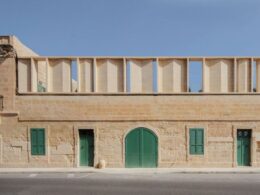The current terminal of Malta International Airport, designed by Raymond Driessen opened in February 1992. Since then, numerous expansions, refurbishments and design alterations have changed and continue to change his original vision.
From the apron [the area of the airport where aircraft are parked], arrivals to Malta are met with a waved roof. I always wanted to know if this roof was supposed to represent the sea and it was this that triggered me to find the architect. However, when I asked if this apron view of the terminal symbolizes the sea, Driessen instantly responded, “No. They are just practical rows of canopies that create a festive sunshade. I never had waves in mind when designing them.”



“Did you know the airport was a design competition? Though I never saw the plans of the other entries, I heard the main other entry was a modern design with lots of glass, steel and concrete. That’s probably why NACO won.”
NACO (Netherlands Airport Consultants) won the competition to build the new terminal. NACO is a world-leading airport consultancy and engineering firm with 75 years of experience in the aviation industry, having worked on projects at 700 airports worldwide.
“Having just designed 10 airports in the Middle East, I travelled to Malta and visited many historic sites around the islands. I realized that the golden limestone defines the country’s landscape and the airport had to be a functional design that would blend in with its surroundings—not stand out,” Raymond Driessen said.



“Visiting Mdina and Valletta, I took photos of muxrabijet, many arches and Lazzaretto on Manoel Island. I wanted my design to reflect Maltese heritage. Of course, the inner structure of the airport is still concrete, but that’s why I chose yellow stone as its shell and it has these arches,” he said.
“There are basically four main types of airports,” Driessen continues. “Whether you design a hub or point-to-point airport, or whether you need, for example, an immigration counter, determines what type of airport you need. Malta Airport is fairly simple, as most visitors come from other Schengen countries and Malta is their final destination, so I opted for the split-level concept.”
“Malta Airport has a unique split-level design that takes advantage of Malta’s landscape. Normally, in airports, you go up a level to reach departures, but then you have to go back down to ground level to board. Here, thanks to the natural height of the runway, passengers only need to go up once. Once they’re at the departures level, they’re already at the same height as the runway,” Driessen explains.

Malta Airport’s maximum capacity was calculated at 6 million passengers a year.
“We were only a small team of seven people at NACO on this project and we ran passenger flow models manually with calculators. The airport passenger simulations decide everything: how many counters you need, how wide each counter should be and then how big the entire space needs to be. Malta Airport’s maximum capacity was calculated at 6 million passengers a year. When designing Malta Airport, we didn’t have access to Excel yet and there was no AutoCAD. I drew everything by hand with a black felt-tip pen—that’s how I always preferred to design. Imagine how happy we were when we could use Excel on future projects. It made life so much easier,” Driessen laughs.



Earlier this year, the airport was awarded the title Best Airport in Europe (in the category of airports which welcome between 5 and 15 million passengers annually) by Airports Council International for the 7th consecutive year in 2024.
“Really?” Driessen responded with a sense of pride and instantly joked, “I guess I should add that to my resume!”
Malta International Airport is expected to welcome 9.3 million passengers this year and is planning a €345 million expansion over the next 5 years. Limestone arches will be used to create visual continuity with the existing building and preserve the terminal’s iconic look.

With thanks to Raymond Driessen. Driessen is 81 years old. He started working for NACO in 1975 and retired in 2008.

This article has been contributed by Patrick van Schaik who initiated this interview with Raymond Driessen at the NACO headquarters in The Hague, the Netherlands.
van Schaik is known for highlighting unsung modern buildings in Malta on his Instagram page Limestonejungle.










